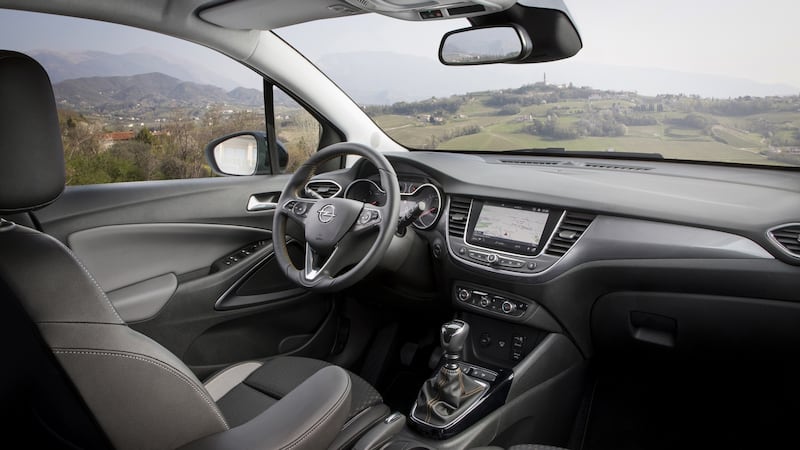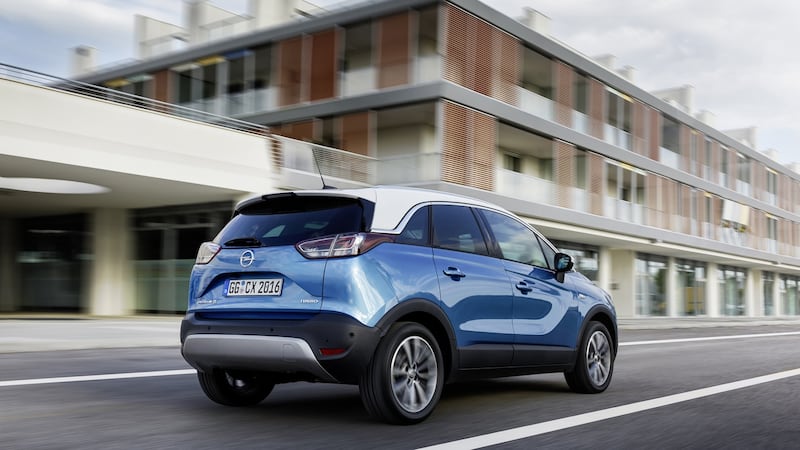There is a big problem for the new Opel Crossland X, something that sits just across the showroom floor from the new small SUV, and it rhymes with "Dastra".
We'll come back to that in a minute, but first – what is a Crossland X and why is it here? It's actually Opel's new small crossover, and also a replacement for the old Meriva MPV, and it shares a chassis and some major mechanical bits with the Peugeot 2008 and Citroen C3 Aircross. Ah, so you'll assume, this must be the first fruits of the much-bandied-about buyout of Opel by the PSA Group that owns Peugeot and Citroen. Well, not quite. The three car brands actually began collaborating on new chassis and engines some time ago, and the forthcoming Grandland X (Opel's rival for the Nissan Qashqai) will share its chassis with the Peugeot 3008 and the Citroen C5 Aircross.
So, this being a replacement for the Meriva, you’ll be expecting it to be seriously clever in the back, right? Wrong again. We will genuinely miss the old Meriva’s rear-hinged back doors (which were seriously useful if you were loading in kids in car seats) and its rear seats which moved, slid, folded, and split in all sorts of ways.


The Crossland’s rear seats are rather more vanilla than that. They split-fold, alright, with a slim centre section doubling up as a ski-hatch or arm-rest, and they do slide back and forth. That can liberate a seriously large amount of extra boot space, as when the rear seats are in the slid-forward position, the boot expands from 410-litres to a whopping 520-litres. At last, a small SUV with a boot big enough for a family. The unfortunate compromise is, obviously, in rear seat room. Maximise the boot, and you’ll be lucky to fit anyone at all in the back. Minimise the boot and, er, to be honest, there’s still not great space back there. It’s adequate, but no more than that.
Things are a little better up front, where we find driver and passenger seats approved by the Aktion Gesunder Rucken, or German Bad Back Association. They are truly, properly comfortable, and even long journeys fail to induce numb-bum, nor thigh-tremble. It does go a bit downhill from there though. The fascia and instrument panel are pulled, more or less directly, from the Corsa hatch, which means everything's reasonably well made, but a bit dour and glum in appearance. That contrasts sharply to the quirkier, more welcoming interiors of the Crossland's French cousins. There are good things – the seven-inch IntelliLink touchscreen is clear and good to use, albeit it has a slightly messy menu system, but the main dials look drab, and items such as the column stalks actually feel quite fragile and cheap.
Under the stubby bonnet, Opel has borrowed engines as well as chassis from PSA, so the EcoTec 1.6-litre diesel is actually the French 1.6-litre BlueHDI engine wearing lederhosen and a false moustache. It's a very good engine, in fairness. Not as refined, overall, as Opel's home-grown 1.6, nor as powerful (120hp plays 136hp) but quieter at low rpm when cold, and with very good economy. Sadly, the six-speed manual gearbox is also brought in from France and its sloppy, loose-limbed action does not bespeak of German precision. The engine, to be honest, doesn't seem to suit the car, surging and growling with rather too much enthusiasm and basically making a nuisance of itself. I suspect the Crossland would be better-suited to the revvy, lightweight 1.2-litre petrol engine.
The handling and ride are basically fine, but are all but invisible from the point of view of a keen driver. The Crossland is tidy through corners, with reasonable steering weight but no actual feedback, and the body tilts over only to a reasonable angle. The ride is a touch stiff in its damping, especially around town (which is disappointing, given that any Crossland will probably spend most of its life in town) but it does improve on the open road. Refinement is only average though with quite a bit of wind and road noise. There’s little point in having Opel’s phone-based OnStar concierge service fitted if you can’t hear what the operator is saying . . .
Style-wise, the Crossland X is actually quite handsome from the front (I really like the new Opel “face” with its counter-sunk grille and narrow lights, it looks well on the Insignia and the Mokka too) but less so from the back, where the “Landau Roof” look taken from the Adam just seems odd.
There is, though, that elephant in the room. And that is the Astra. While you’d think that the Crossland’s biggest problem would be the similarly-sized, similarly-priced Mokka X, it is actually the Astra hatch which proved the biggest impediment to any enjoyment I might have had in the small SUV.
You can get a basic Crossland (which is actually very well equipped, complete with OnStar and a wifi hotspot) for just €21,995 in SC trim. However, our test car, an SE, was bumped up from a €26,495 base price to more than €28,000 with a few optional extras. And that’s a big tripwire. For that same money, I could have bought an Astra Sport Tourer estate, with the excellent 1.4 Turbo petrol engine, in range-topping Elite trim, with a bigger boot and more space in the back seats. And a chassis that sparkles and delights, rather than merely trudges along. The Crossland X is a significant car for Opel, not least because it is the first fruits of that Franco-German tying of the knot, but it’s rather lacklustre in comparison to the excellence of the Astra.
The lowdown: Opel Crossland X 1.6 EcoTec D SE
Power: 120hp.
Torque: 300Nm.
0-100km/h: 9.9sec.
Top speed: 187kmh.
Claimed economy: 70.6mpg (4.0 litres/100km).
CO2 emissions: 105g/km.
Motor tax: €190.
Price: €28,995 as tested; Crossland X range starts at €21,995.
Verdict: A German attempt at a croissant. Edible, but not especially tasty.
Our rating: 2/5.












